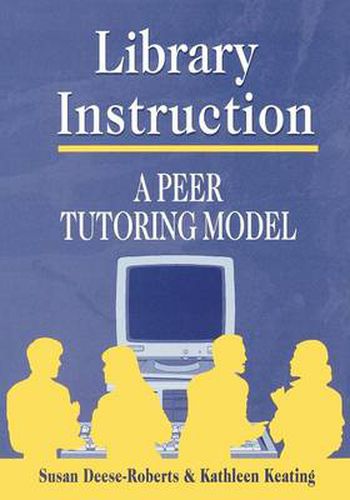Readings Newsletter
Become a Readings Member to make your shopping experience even easier.
Sign in or sign up for free!
You’re not far away from qualifying for FREE standard shipping within Australia
You’ve qualified for FREE standard shipping within Australia
The cart is loading…






Overburdened and understaffed due to an unprecedented influx of questions from patrons about using electronic resources? Instituting a peer tutoring programme can save your budget, your time and your sanity. This book demonstrates how you can meet student demands for instruction by using peer tutors to handle some of the responsibilities traditionally met by reference librarians. The overload problem is common and continues to grow because changing technologies and diversifying student populations mean a higher demand for library instruction at most academic libraries. This practical, step-by-step plan for developing and implementing a peer tutoring programme will improve library services and make your job easier. With this book you will learn how to set up an effective peer tutor training programme. Through the eight detailed training sessions outlined here, your tutors will learn to teach library patrons online search concepts and skills such as how to select and manipulate appropriate databases, navigate the Web, and evaluate the information they will find. Tutors also train as guides to introduce students to the campus library through scheduled tours. After finishing all training sessions outlined, tutors are able to answer any questions about accessing the library cataloguing system; understanding bibliographic citations; evaluating sources including specific criteria regarding scholarly versus popular literature; and judging the accuracy, authority and objectivity of all information sources. The authors cite numerous examples of successful peer tutoring programmes at various universities, as well as the mechanisms that turned their own University of New Mexico pilot programme into a success. After touching on the establishment of peer tutoring programmes in the K-12 setting, appendices provide documents for pursuing certification of your planned programme through The College Reading and Learning Association as well as the easily reproducible training agenda and exercises from the University of New Mexico programme. Everything an academic librarian or adminstrator needs to start putting peer tutoring in motion is in this hands-on guide.
$9.00 standard shipping within Australia
FREE standard shipping within Australia for orders over $100.00
Express & International shipping calculated at checkout
Overburdened and understaffed due to an unprecedented influx of questions from patrons about using electronic resources? Instituting a peer tutoring programme can save your budget, your time and your sanity. This book demonstrates how you can meet student demands for instruction by using peer tutors to handle some of the responsibilities traditionally met by reference librarians. The overload problem is common and continues to grow because changing technologies and diversifying student populations mean a higher demand for library instruction at most academic libraries. This practical, step-by-step plan for developing and implementing a peer tutoring programme will improve library services and make your job easier. With this book you will learn how to set up an effective peer tutor training programme. Through the eight detailed training sessions outlined here, your tutors will learn to teach library patrons online search concepts and skills such as how to select and manipulate appropriate databases, navigate the Web, and evaluate the information they will find. Tutors also train as guides to introduce students to the campus library through scheduled tours. After finishing all training sessions outlined, tutors are able to answer any questions about accessing the library cataloguing system; understanding bibliographic citations; evaluating sources including specific criteria regarding scholarly versus popular literature; and judging the accuracy, authority and objectivity of all information sources. The authors cite numerous examples of successful peer tutoring programmes at various universities, as well as the mechanisms that turned their own University of New Mexico pilot programme into a success. After touching on the establishment of peer tutoring programmes in the K-12 setting, appendices provide documents for pursuing certification of your planned programme through The College Reading and Learning Association as well as the easily reproducible training agenda and exercises from the University of New Mexico programme. Everything an academic librarian or adminstrator needs to start putting peer tutoring in motion is in this hands-on guide.